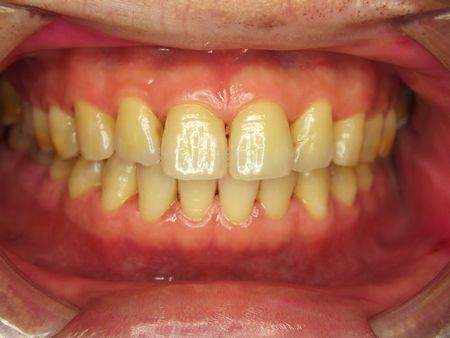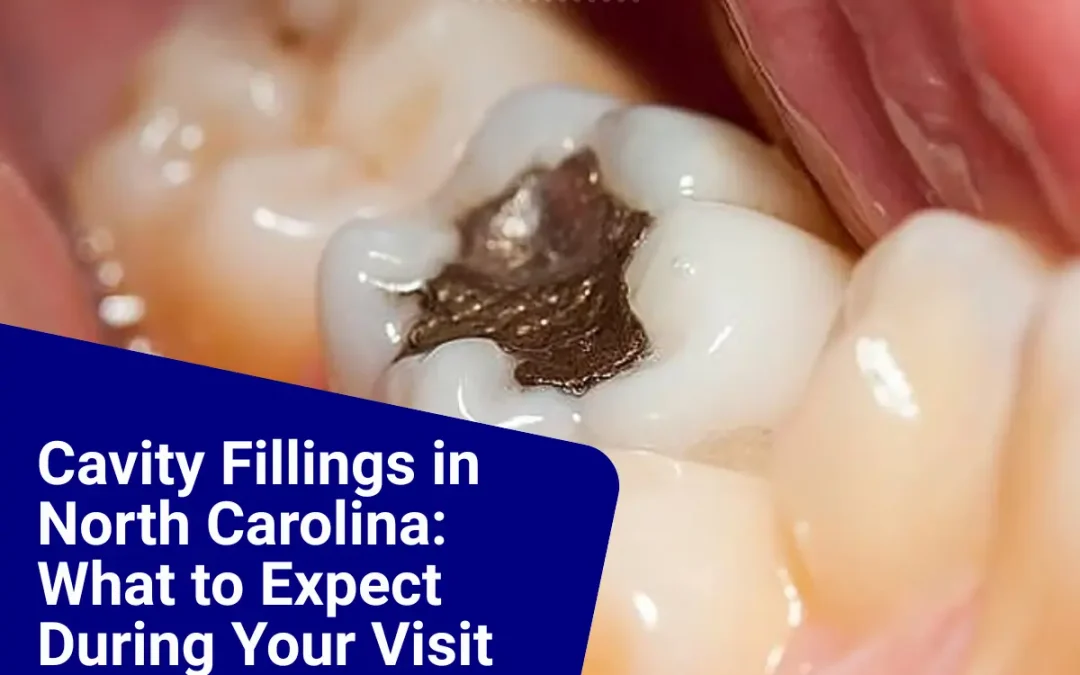Ever felt that sudden pain when you sip something cold or bite into your favorite sweet treat? That painful sensation often hints at a cavity, a tiny but troublesome hole in your tooth.
For this, fillings are the perfect solution. While the thought of a “filling” might sound scary, it’s one of the most common and effective ways dentists help you keep your smile healthy and pain-free. In North Carolina, dental professionals are ready to address these issues, stopping decay in its tracks and restoring your tooth’s strength.
What Are Cavity Fillings?
Cavity fillings, also known as dental fillings, are a restorative dentistry treatment used to repair a tooth that has been damaged by decay. When a cavity forms, it creates a small hole or weakened area in the tooth.
If left untreated, the decay can spread and cause pain, infection, or even tooth loss. To stop this process, a dentist removes the decayed portion of the tooth and fills the space with a special material, known as a filling. This helps restore the tooth’s strength, shape, and function.
Fillings also help protect the tooth from further damage by sealing off areas where bacteria can enter. The procedure is quick, safe, and typically done in a single visit.

Types of Dental Fillings Available in North Carolina
When it comes to dental fillings in North Carolina, you have several choices, each with its benefits. Your dentist in North Carolina will discuss which option is best for you based on the cavity’s size, its location in your mouth, your budget, and your personal preferences.
1. Composite Resin Fillings (Tooth-Colored Fillings)
These are the most popular dental fillings options in North Carolina because they match the natural color of your teeth. Made from a mixture of fine glass particles and plastic, composite fillings bond directly to your tooth, requiring less removal of healthy tooth structure. They are great for visible teeth and can last typically 5-10 years or more with good care.
2. Amalgam Fillings (Silver Fillings)
These are a strong and cost-effective option, made from a blend of metals including mercury, silver, tin, and copper. Amalgam fillings are very durable and can last 10-15 years or even longer, especially in back teeth where chewing forces are strong. However, their silver color is noticeable.
3. Porcelain (Ceramic) Fillings / Inlays & Onlays
These fillings are also tooth-colored and made from porcelain. They are custom-made in a lab to fit your tooth perfectly. Porcelain fillings are highly aesthetic and stain-resistant, lasting around 10-15 years. They are generally more expensive than composite or amalgam fillings and may require more than one visit.
When Does One Need a Cavity Filling?
You typically need a dental filling when a part of your tooth has been damaged or lost. The most common reason for this is a cavity, which is a hole in your tooth caused by decay. However, fillings can also be used to repair teeth that are cracked, chipped, or worn down from grinding or aggressive brushing.
Here are the common signs that might indicate you need a dental filling:
- Toothache or Persistent Pain
- Sensitivity
- Visible Holes or Pits
- Food Getting Stuck
- Broken or Chipped Tooth
- Cavities
What to Expect During Your Cavity Filling Visit?
Getting a cavity filled is a common and usually comfortable procedure. Here’s a simple breakdown of what will happen during your visit to a North Carolina dental office, step-by-step:
Step 1: Tooth Examination
The first thing your dentist will do is carefully look at the tooth that’s causing you trouble. The dentist will thoroughly examine your tooth to understand the issue. They might use small dental tools to check the surface of your tooth, and they will take an X-ray if needed.
Step 2: X-Ray and Choice of Material
After the initial check, your dentist will take an X-ray of the affected tooth. This X-ray helps them see how deep the decay goes. If the infection has reached the very center of the tooth (called the pulp), a different procedure called Root Canal Therapy might be needed.
However, if the infection hasn’t reached the pulp, a dental filling will work perfectly. At this point, your dentist will discuss the best filling material for you and help you choose the one that suits your needs and budget.
Step 3: Numbing and Decay Removal
To make sure you’re comfortable and feel no pain, your dentist will numb the area around the tooth. This is usually done with a quick injection. Once the area is numb, they will carefully remove the decayed part of your tooth. This is typically done using a small, high-speed dental drill with special tools called burs, or sometimes a spoon-shaped tool called a spoon excavator.
Step 4: Filling Using Restorative Material
After all the decay is removed and the tooth is clean, your dentist will begin inserting the chosen filling material into the prepared space. Common filling materials include Glass Ionomer Cement (GIC), composite resin, amalgam, gold, and porcelain.
For custom-made porcelain fillings (called inlays or onlays), your dentist might need to take an impression of your tooth. This impression is then sent to a dental lab where the porcelain filling is crafted to fit your tooth perfectly.
Step 5: Waiting for the Filling to Set
The time it takes for your new filling to become completely hard depends on the material used. If you have a composite filling, your dentist will use a special “curing light” to quickly harden the material layer by layer.
Amalgam fillings also set over time, though they don’t require the special light. Your dentist will let you know how long you need to wait before you can comfortably chew on that side, ensuring the filling has fully set.
Step 6: Bite Adjustment
Once the filling has hardened, your dentist will check your bite to make sure the new filling isn’t too high or uncomfortable. They will place a thin piece of colored paper (often called articulating paper) in your mouth and ask you to bite down.
The paper leaves marks on any “high spots” on the filling. Your dentist will then gently remove these high spots, making small adjustments until your bite feels completely natural and comfortable. These adjustments are crucial so the filling doesn’t interfere with your daily activities like biting and chewing.
Step 7: Polishing and Finishing
The final step is to polish and finish your new filling. Your dentist will use specialized polishing tools to make the filling smooth and glossy, just like the rest of your natural tooth. This quick and painless step leaves you with a beautifully restored tooth that looks and feels great!
Aftercare Tips for a Cavity Filling
Once your filling is in place, a little care can go a long way in making it last. Here are some aftercare tips for a cavity filling you can try:
- Be Gentle with Chewing: For the first few hours after your filling, especially if you’ve had a metal (amalgam) filling, avoid chewing on the treated side. It’s best to let the filling fully set.
- Watch for Sensitivity: It’s normal to feel some sensitivity to hot, cold, or pressure for a few days after a filling. This usually goes away on its own.
- Maintain Good Oral Hygiene: Continue brushing and flossing regularly. Use a soft-bristled toothbrush and be gentle around the filled tooth.
- Avoid Sticky and Hard Foods: For a short time, try to avoid very sticky candies, tough meats, or hard nuts on the filled tooth, especially if it’s still sensitive.
- Limit Sugary and Acidic Drinks: Sugary sodas, fruit juices, and acidic foods can be harsh on your teeth and fillings. Limiting these can help prolong the life of your filling and prevent future decay.
- Rinse Gently with Saltwater: A warm saltwater rinse can help keep the area clean and soothe any minor irritation. This is especially helpful on the first days after your procedure.
How Much Do Cavity Fillings Cost in North Carolina?
The cost of a cavity filling in North Carolina depends on a few factors, including the type of material used, how many teeth need to be filled, and the clinic you visit. In general, composite (tooth-colored) fillings tend to cost more than amalgam (silver) fillings, but the natural appearance may be worth it for many patients.
Typical Price Range
In North Carolina, cavity fillings usually range from $100 to $300 per tooth, depending on the material. Composite fillings are often in the $150-$250 range, while amalgam fillings may cost a bit less.
Factors Affecting Cost
Here are some factors that affect the overall cost of cavity fillings:
- Type of filling material
- Number and size of cavities
- Location of the tooth (front or back)
- Insurance coverage
Conclusion > Cavity Fillings in North Carolina
Cavity fillings are a simple but important part of keeping your teeth strong and healthy. Whether you’re choosing between different filling types or wondering about the cost, knowing what to expect makes the experience smoother.
If you’re in North Carolina (especially near Pineville), you’ll find high-quality, affordable dental services that can help you restore your smile with confidence. Don’t wait for a small cavity to become a big problem. Schedule your visit today and take the first step toward better dental health.

